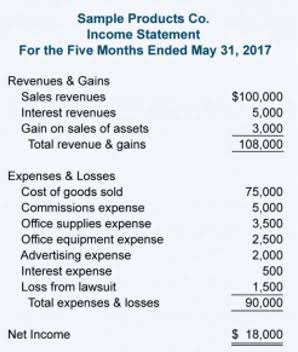- Eylül 30, 2020
- |Bookkeeping
- | 0

To be a successful forensic accountant, one must be detailed, organized, and naturally inquisitive. This position will need to retrace the steps a suspect may have taken to cover up fraudulent financial activities. Understanding how a company operates can help identify fraudulent activities that veer from the company’s position. Some of the best forensic accountants have put away major criminals such as Al Capone, Bernie Madoff, Ken Lay, and Ivan Boesky. Remember, the general ledger holds the key to understanding Bookkeeping for Consultants the financial health of an organization.

Order to Cash
- In this blog post, we’ll delve into each step, providing examples for better comprehension.
- It’s where all the individual tales of your transactions come together to form a cohesive narrative.
- A journal (also known as the book of original entry or general journal) is a record of all transactions.
- Often, an assignment or service can stretch over weeks or months.
- Closing accounts is the last step, where you have to close all temporary accounts such as expenses and revenues (mostly income statement items) to retained earnings and owner’s equity account.
- Some of the best forensic accountants have put away major criminals such as Al Capone, Bernie Madoff, Ken Lay, and Ivan Boesky.
- Proper documentation also strengthens loan applications and financial reporting.
Assets and equity are just two of the six classifications of accounts, the other four being liability, withdrawal, revenue, and expense. Think of this step as the grand finale of a spectacular fireworks show. It’s the moment when the sky lights up with a dazzling display, marking the end of an eventful night. In the accounting cycle, closing the accounts is that grand finale.
Step 10: Post closing trial balance
- After all transactions are logged in the general ledger, the next step is to make sure the entries balance out, meaning total debits equal total credits.
- This new trial balance is called an adjusted trial balance, and one of its purposes is to prove that all of your ledger’s credits and debits balance after all adjustments.
- Remember, the general ledger holds the key to understanding the financial health of an organization.
- Just as a garden needs regular pruning and adjusting to ensure it grows properly, your financial records need regular adjusting entries to ensure they accurately reflect your business’s financial health.
- Let’s read more about normal balances of accounts and rules of debit and credit here.
Using the rent example, the cash account would be identified as an asset account, and the rent expense account is identified as an expense account. Transactions can be external transactions or internal transactions. External transactions involve the business and a third party such as a supplier, they are easier to analyse as there will always be source documents evidencing the transaction.
Free Course: Understanding Financial Statements
- When the post-closing trial balance is good, you’ve reached the completion of the accounting cycle at year-end.
- Think of the general ledger as a summary sheet where all transactions are divided into accounts.
- Computerized accounting systems and the uniform process of the accounting cycle have helped to reduce mathematical errors.
- It is not taken from previous examples but is intended to stand alone.
- Temporary accounts are closed, ready for the next accounting period, and the net income or loss and dividends are transferred to the retained earnings account.
A typical accounting cycle is a 9-step process, starting with transaction analysis and ending with the preparation of the post-closing trial balance. One of the main duties of a bookkeeper is to keep track of the full accounting cycle from start to finish. The cycle repeats itself every fiscal year as long as a company remains in business. You can open a new accounting period to begin recording transactions for the accounting cycle of the next month and year.
With accounting software, users can choose to run the unadjusted trial balance report or set up selected reports to run automatically as part of the month-end financial close. Tipalti AP automation syncs data with your ERP or accounting software. Your ERP system creates journal entries to record accounts payable from the accounts payable subsidiary ledger totals. The purpose of the accounting cycle is to record transactions and periodically close the books, including preparing financial statements. The accounting cycle is a standard, 8-step accounting process that tracks, records, and analyzes all financial activity and transactions within online bookkeeping a business. It starts when a transaction is made, and ends when a financial statement is issued and the books are closed.

Prepare an Unadjusted Trial Balance

The operating cycle can be expressed in a formula as the sum of the financial analysis ratios for days’ sales outstanding and days in inventory. The operating cycle measures the days between purchasing inventory and collecting cash from the sale of inventory items. Understanding the operating cycle of your business is essential for cash flow management.

Step 2: Journal Entries for Transactions
Each one tells a story about the financial health of your business. Now, let’s have a closer look on the complete accounting cycle process by performing the following example step by step. For example, you have made an analyze transactions accounting cycle entry where you debited the Entertainment account for $40 and credited cash $40. Now, this transaction will affect the Cash and Entertainment account only, where, on the Cash T Account, you will decrease or put his $40 amount on the right side of the T account.

For example, all entries relating to sales are recorded in the sales account. Similarly, all transactions resulting in inflow and outflow of cash are entered in the cash account. To reconcile inventory balances, businesses take cycle counts, which are sample inventory counts during the year. Companies take a comprehensive physical inventory to compare count quantities with perpetual inventory balances in a month with lower business activity. In the physical inventory reconciliation process, cost accounting makes necessary and approved adjustments to the detailed financial records and journal entries. The second step in the process isrecording transactions to a journal.
